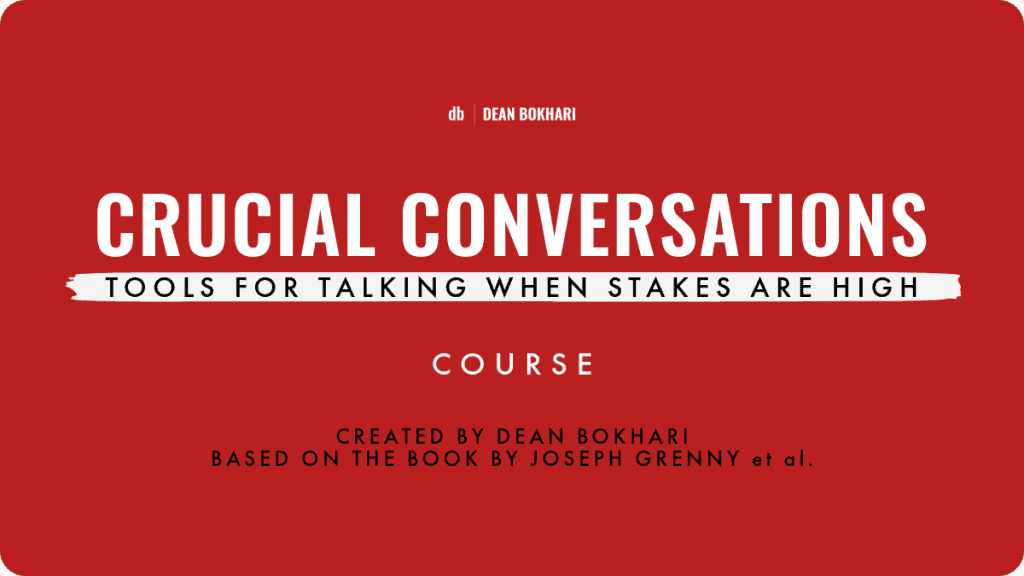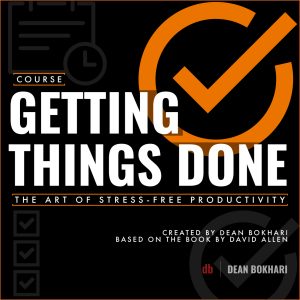
This is a preview lesson from the Crucial Conversations Course. Press Play below to start listening. Then, scroll down to follow along. 👇
In our previous lesson, we covered how crucial conversations go sideways. And the big takeaway was this: if people feel threatened during a conversation, they resort to silent or violent reactions, and the conversation fails… So how do we ensure that the atmosphere of a conversation remains safe? That’s what we’ll be diving into in this lesson.
Make it Safe with Mutual Purpose + Respect
First things first: When others move to silence or violence, you need to step out of the conversation and Make it Safe. Once safety is restored, go back and continue the dialogue.
The key is to step out of the content of the conversation: to not get stuck on what the other person or people are saying.
Next, we start laying the foundation of your conversation on two things:
(1) a Mutual Purpose, and (2) Mutual Respect.
Let’s break both of these down:
- Mutual Purpose. Finding mutual purpose is important because it’s what binds two or more people together in a conversation. If people genuinely feel they have a mutual purpose, they’ll try to look past their differences and communicate with each other to achieve that purpose. Put simply, every participant needs to feel like they’re contributing to any decisions that get made as a result of the conversation; people need to feel like they’ve got some skin in the game.
- Mutual Respect. Mutual respect is just as important as mutual purpose. Respect is absolutely critical for any successful conversation. If your conversation partners feel like you don’t respect them, you’ll either get a silent reaction (i.e. withdrawal, no communication, sarcasm) or a violent reaction (i.e. shouting, anger, controlling behavior.) Bottom line: If you want people to be invested, make sure they feel respected.
Enjoying this preview lesson?
Check out the full version of the Crucial Conversations training program here →
Establish mutual purpose in crucial conversations
Define a mutual purpose—once it’s clear, those who are part of the conversation will strive towards it as well…
Crucial Conversations Example:
How to establish mutual purpose
For example, let’s say you were just offered a once-in-a-lifetime promotion at work; the kind of opportunity that could really take your career to the next level.
But the downside is that you and your family will have to move to another state.
This puts you at odds with your partner.
Initially, you and your partner seemingly have completely different goals: You want the promotion. Your partner doesn’t want to move.
At this point, it’s important to work on finding a more general goal that’s in both your interest as well as your partner’s.
For instance, define the long-term needs of the family, and see if your promotion aligns with those needs. Talk it out. Work on coming up with something together.
This will immediately help you and your partner establish common ground.
And no matter what the outcome of your discussion, you’ll both be more likely to sincerely consider the available options.
In the end, your partner may be persuaded to let you take the promotion and move; or you may decide that finding a better opportunity in the same area is a better option. Either way, it’ll be a stronger decision because both you and your partner were involved in making it.
If you want people to be invested, make sure they feel respected
Even when you’re about to criticize an employee, you can do so without disrespecting them. A good way to do this is by using the technique of alternating between praise and criticism.
Crucial Conversations Example:
How to Criticize Respectfully
For example, let’s say you want Jimmy to be more punctual. Here’s how it might go:
- YOU: “I appreciate all your hard work on XYZ project, Jimmy.”
- JIMMY: “Thanks so much!”
- YOU: “You know, if there were just one area I’d like to see you improve upon, it would be your punctuality. Do you think you could work on ensuring you’re at our project meetings on time from now on? It would really help maintain the high-quality work you’re known for as you continue to take on new projects in the future.”
- JIMMY: “Absolutely, boss. I apologize for showing up late and will make sure it doesn’t happen again. I’ll be on time, every time.”
- YOU: “Thank you, Jimmy… And hey—keep up the quality work, it’s really showing.”
Steps to use this in your crucial conversations:
- Start positive.
- Place the area of improvement in the middle.
- Finish off strong with another positive statement.
Use the steps outlined above, and your conversations—even the difficult ones—will be far more positive and productive. You’ll also increase your chances of achieving win-win solutions.
Crucial Conversations Example:
How to use mutual purpose + respect to facilitate “safer” conversations
When people don’t feel safe, it’s usually because they either believe you don’t respect them, or they believe you don’t share the same goals (mutual purpose). The first step toward restoring safety is to address these concerns directly.
For example, let’s say you’re in disagreement with a colleague about how to allocate resources for a project. Things get tense, and you notice they’re becoming defensive.
What can you do to prevent the conversation from spiraling out of control?
Re-establish safety by reminding them that you both want the same thing (mutual purpose)—which is to finish the project successfully. Immediately thereafter, you want to express respect for their concerns.
Here’s what this might sound like in action:
“I want to make sure we’re on the same page because I know we both care about making this project a success. I respect your opinion, and I’m interested in finding a solution that works for both of us…”
☝️ Saying something like this can defuse the tension almost immediately.
Spot Safety Risks by Looking for Silence + Violence
One of the most useful skills is learning to recognize when safety has been violated.
As you know by now: people tend to react in one of two ways when they feel unsafe:
- silence (shutting down, avoiding the conversation) or
- violence (getting aggressive, trying to control the conversation.)
Example of silence: I was in a meeting with my team recently when I noticed one of our most valuable employees, Shafi, suddenly stopped contributing after a somewhat tense moment in our discussion. Initially, I didn’t realize what was happening. After the meeting, I found out that Shafi felt like the group didn’t value his input—so he began to withdraw and shut down—moving into silence.
Example of violence: On the other hand, there are moments when people feel the need to control or overpower the conversation when safety is compromised. I’ve been in conversations where someone begins to talk over everyone, raise their voice, and force their opinions—classic signs of violence.
The important thing to remember is that both responses come from a lack of safety.
Enjoying this preview lesson?
Check out the full version of the Crucial Conversations training program here →
Two Key Skills to Make it Safe
Apologize (when appropriate)
If you realize that something you’ve said or done resulted in someone feeling disrespected or unheard, you can move the conversation back to safety with a genuine apology.
Crucial Conversations Example:
How to apologize
For example, if you’re in the middle of a conversation and realize you’ve just interrupted someone or mistakenly dismissed their point, a quick apology—with eye contact—can go a long way:
“So sorry, Rob. I didn’t mean to cut you off. I value your opinion and want to hear what you have to say.”
Use Contrasting (to fix misunderstanding)
Sometimes people feel disrespected during crucial conversations even when we haven’t said or done anything disrespectful. If you haven’t done anything wrong but the other person still doesn’t feel safe, then your next best tool is a skill called contrasting.
Contrasting is a powerful way to clarify your intentions. It involves explaining what you don’t mean, and then what you do mean.
Crucial Conversations Example:
Clarify what you don’t mean + what you do mean
You’re giving feedback to a team member and you notice they’re getting defensive. In this scenario, it would be smart to use contrasting by saying something like this:
“Steve, I don’t want you to think I’m questioning your ability to do the job. What I do want, is to have an open discussion about how we can handle deadlines better moving forward.”
☝️ This clears up any misunderstandings and helps to restore a sense of safety.
CRIB to Get to Mutual Purpose
If people feel like you don’t share the same goals, they won’t engage fully in the conversation.
This is where the CRIB method comes in handy—use it to get back to mutual purpose. CRIB stands for: Commit, Recognize, Invent, and Brainstorm.
Crucial Conversations Example:
How to use the CRIB Method to restore safety
For example, imagine you’re in a conversation with a business partner about a new direction for your company. You suggest focusing on a specific market segment, but your partner seems resistant and starts pulling away. Instead of pushing for your strategy, establish safety by CRIBing your way back to mutual purpose.
- COMMIT to seeking mutual purpose. Commit to stay in the conversation until you come up with something that works for everyone.
- You start by saying something like, “I think we might be seeing this differently, but I want to make sure we’re both aligned on what’s best for the company. Can we work together to figure that out?”
- RECOGNIZE the purpose behind the strategy. Ask people why they want what they’re pushing for. Separate what they want with the purpose it serves.
- Acknowledge their underlying concerns. “It sounds like you’re worried that focusing on this market segment could limit our growth opportunities. I understand that.”
- INVENT a mutual purpose. If you’ve clarified everyone’s purposes, but still haven’t gotten to safety, try to invent a more inspiring purpose than the one that’s keeping you in conflict.
- Find a higher-level purpose that you can both agree on. “At the end of the day, we both want what’s best for the company’s long-term success, right?”
- BRAINSTORM new strategies. Look for a solution that serves everyone.
- Now that you’ve identified a shared purpose, you can brainstorm together. “What if we explore some other markets that might help us grow while still considering this segment?”
Actionable Insights
Making it Safe is about recognizing when a conversation goes off track and knowing how to steer it back to healthy dialogue by addressing people’s need for safety and respect. When you get this right—when you foster safety—you open the door to honest dialogue and better outcomes in your crucial conversations. Keep these actionable ideas in mind to make safety the standard in every dialogue:
- 1. Notice when safety is at risk. Look for signs of silence (people withdrawing, shutting down) or violence (people becoming aggressive, trying to dominate). When you see the signs, STOP—and reestablish safety.
- 2. Use contrasting to clarify your intentions. When someone misinterprets your words, use contrasting to explain what you don’t mean and what you do mean, to avoid further misunderstandings.
- 3. Apologize when necessary. A genuine apology can restore safety and keep the conversation moving forward.
- 4. Focus on mutual purpose. Constantly remind people that you’re working toward the same goal. If they feel like you’re on their side, they’re more likely to engage and contribute to a productive dialogue.
If you enjoyed this preview lesson, join me for the full Crucial Conversations training program. 👇
This was a preview lesson from the Crucial Conversation Course by Dean Bokhari, based on the book by Joseph Grenny, et al. Friendly disclaimer: I (Dean Bokhari) am not affiliated with the authors of Crucial Conversations in any capacity, nor are any of my companies.


